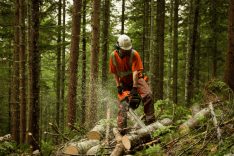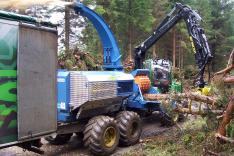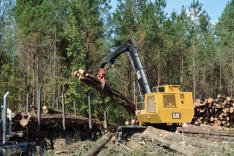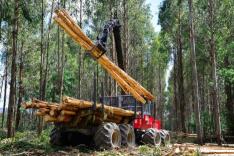GSatTrack and Forestry Telematics
In the summer of 2000, fire destroyed millions of acres of forest across the United States. In response, M. Chad Bolding, a Graduate Research Assistant, and Associate Professor Dr. Bobby L. Lanford at the School of Forestry and Wildlife Sciences of Auburn University performed a study to investigate the feasibility of harvesting to reduce forest fuel buildup, which would reduce potential materials that could burn during a forest fire, while simultaneously producing energy wood. They summarized that cut-to-length harvesting coupled with a small in-woods chippers provide a low impact way to harvest pre-commercial trees and tops along with merchantable logs. They projected that a cut-to-length small chipper system would be an efficient way of reducing forest fuel loads and less expensive than fire suppression and stand-replacement costs after wildfire. Energy wood from fuel reduction harvesting could be used as an alternative energy source. The benefits of energy wood become more important as fuel prices increase. The feasibility study suggests that if energy equivalent values were obtained, a cut-to-length small chipper system could provide income rather than expense for site conversion, and cleanup operations.
About GSatTrack
GSatTrack is a web-based, integrated satellite and GSM tracking solution, compatible with modern web browsers and works on a multilingual platform that brings together all the positions of every manufactured product under one location and displays and manages them in a single unified interface. With GSatTrack, asset locations and movements - including position, speed, altitude and heading - are tracked in real-time worldwide via GPS updates.
By using GPS satellites with the latest hardware and technology, any asset on earth, whether it's people, vehicles, containers, or any moving object can be tracked. Our technology allows the integration of all types of tracking equipment into one easy to use platform. The tracking equipment determines its location by triangulating a position using GPS (Global Positioning System) and then transmits this information via GSM, Satellite, or VHF to a central server for processing. Any operator can view and control any number of assets simultaneously, in near-real-time.
The Customer Situation
The Forestry industry makes use of several different types of large machines to ensure every part of a tree is harvested and used. Whether it's hardwoods for lumber or softer woods for paper products every bit of timber can be used ensuring nothing goes to waste. One of the most important parts of these operations is the large scale chippers. While location information for these units are important what is truly important to a forestry operation is the RPM data from these units. If the chipper runs too high it can damage the mechanical integrity of the machine. Understanding the RPMs of the chipper also allows the forestry operator to control how big the chips produced are. This allows the forestry operator produce both chips that are perfect for paper mill products and also produce smaller chips which will reduce the chance of forest fuel fires.
The Challenge
The first challenge to attaining RPM data on a chipper is making sure that either the proper sensors are in place or that there is a direct link to RPM data through a connection point on the chipper. Finally these large pieces of machinery rarely operate in areas where cell coverage is consistent or even available. Meaning any solution would require either a satellite network or a hybrid solution making use of both cellular connectivity and satellite networks when the cellular connectivity was unavailable.
The Solution
Having worked with large scale forestry operations around the world the engineers at GSE are not unfamiliar with industrial machinery or the harsh environments where they operate. This familiarity allowed our team of engineers to use common technologies and IOT satellite terminals to gather the RPM data. The device that was ultimately chosen to achieve the integration with the chipper was the IDP-782 from Orbcomm. This hybrid satellite terminal already had standard interface connections via RS-232 and RS-485. Being able to connect to data from the chippers via these ports allowed the first challenge to be met. GSE was able to deliver RPM data directly from the chippers. Because the terminal also made use of various connectors this meant that regardless of the age of the chipper, there was still a way to tap into the data.
Because the IDP-782 terminal operated as a hybrid terminal collecting data and sending it out via both cellular and satellite connectivity, the client could be assured that no matter where their chippers were operating, they always had their data. But simply having data is never enough. What makes GSatTrack and the solutions GSE provides to its’ customers so important is being able to utilize the data in a way that makes sense. This meant creating rules around the data. By creating alerts to notify when the chippers RPM was too high the industrial machine could be managed and either brought within safe operating thresholds, or turned off so as to not cause further damage to the machinery .Finally the RPM data collected allowed alerts to be created around how long the machine was operating and what RPM speed. This meant that the forestry operator could set intervals for chipping product in the appropriate size for their needs in the proper quantities needed rather than using guesswork or visual confirmation from teams working on the ground.
The Result
With the forestry company now able to measure their chippers’ RPM allowing them to make decisions immediately and with precision that cannot be achieved by workers on the ground. This meant chips produced in the correct quantity and the appropriate size for their use. Understanding the RPM data meant less chance for damaging the large and very expensive chippers which directly correlated to less down time and more money spent paying technicians to fix the industrial chippers. Finally as an unintended positive consequence, the forestry operators were able to manage the piles of chips better. Understanding the direction of where the chippers were pointed and for how long meant that piles of chips were controlled and more easily managed by truck drivers delivering these loads of chips.
Bolding, M. Chad; Lanford, Bobby L. 2001. Forest fuel reduction through energy wood production using a small chipper/CTL harvesting system. In: Wang, Jingxin; Wolford, Michelle; and McNeel, Joe. Eds. Proceedings of the 24th annual Council on Forest Engineering meeting: Appalachian hardwoods; managing change; 2001 July 15-19; Snowshoe, WV. Corvallis, OR/USA: Council on Forest Engineering: 65-70. [CDROM]







